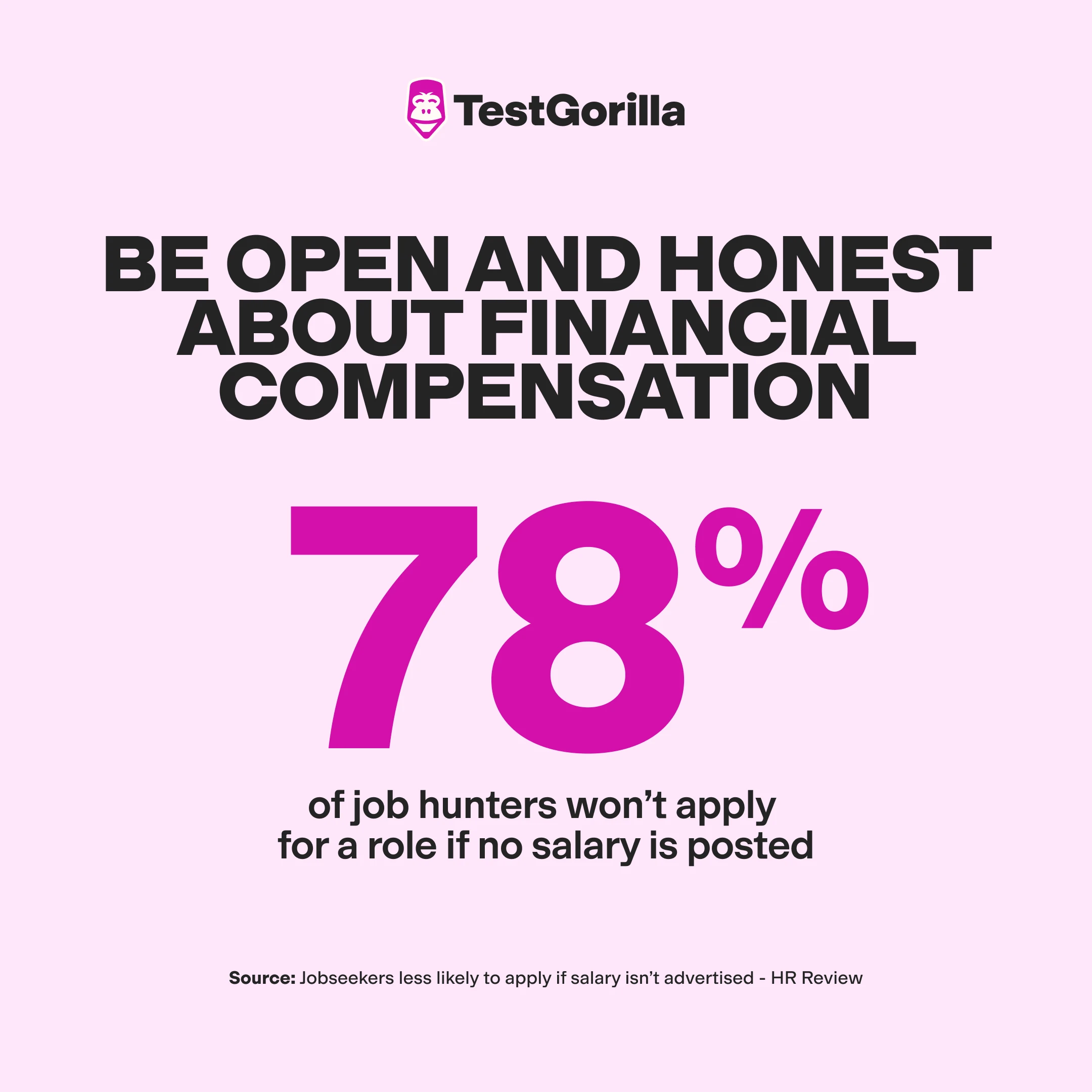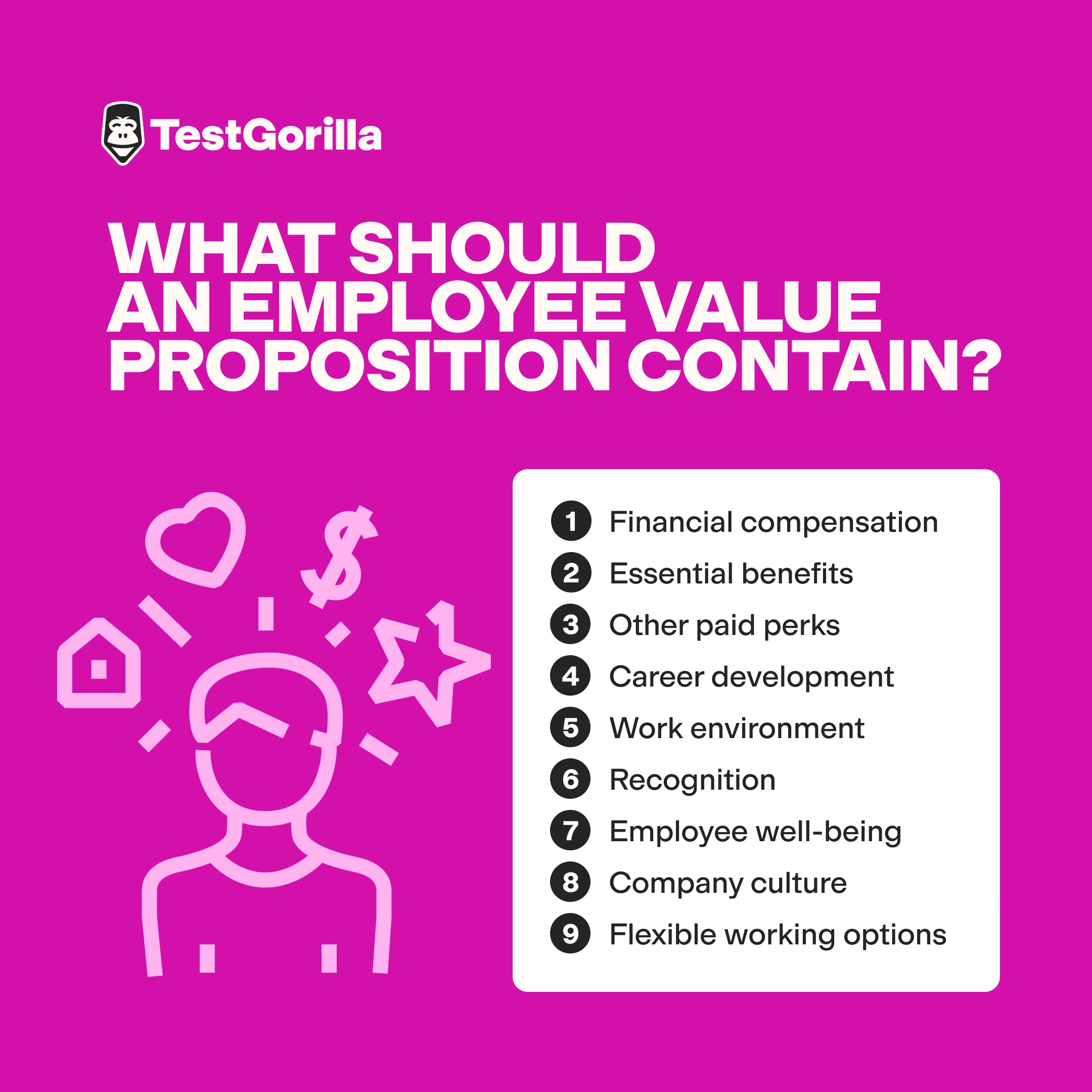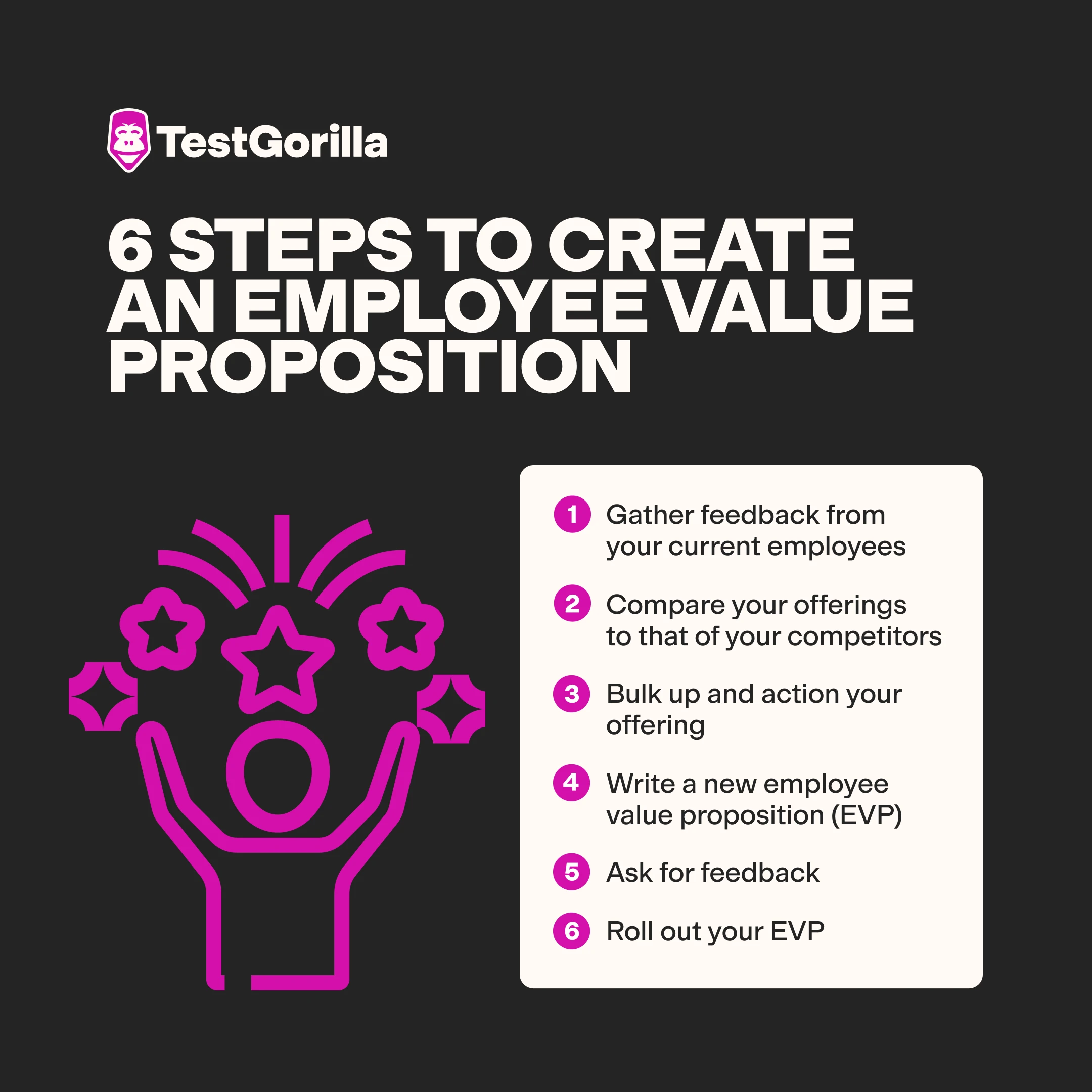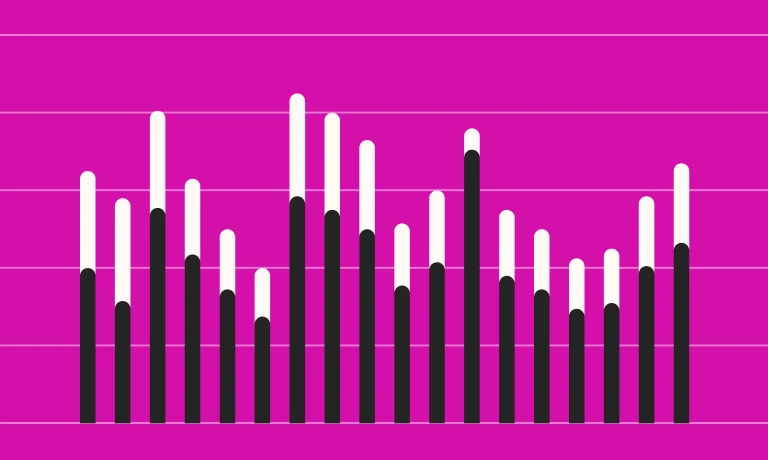Employee value proposition: What it is & when you need one
What’s the best way to incentivize productivity and promote your brand? Is it compensation? A good work-life balance? Upskilling employees with skills assessments?
As an HR professional, you may already know that these compensation factors are some of the key parts of an employee value proposition (EVP). But what other factors should yours include, and how do you go about writing one? Are there any common pitfalls to avoid?
In this article, we explore exactly what to include in an EVP, provide step-by-step guidance on how to write one from scratch and offer a handy template to help you start planning.
Table of contents
- Key takeaways
- What is an employee value proposition?
- What are the key elements of an EVP?
- When to use an employee value proposition?
- How to create an employee value proposition in 6 steps
- 3 mistakes to avoid when writing an EVP
- Employee value proposition planning template
- Attract top talent with TestGorilla
- FAQs
Key takeaways
Your EVP summarizes the compensation package employees and job applicants can expect to receive in exchange for their time and expertise.
EVPs can include tangible and intangible rewards, such as pay, PTO, parental leave, casual Friday, etc.
You can use your EVP to guide strategic planning, mergers and acquisitions, recruitment, and performance management.
Your EVP should align with your overall business strategy to ensure it supports your company’s long-term goals.
What is an employee value proposition?
An employee value proposition (EVP) is a document that explains the total compensation package offered to colleagues in exchange for their time, performance, and experience. The salary you offer is only a small part of your EVP. It also includes other types of employee rewards, both tangible and intangible.
Tangible rewards are any rewards you can see and measure – for example, employee salaries, medical or dental insurance, and retirement plans like 401(k)s. Intangible rewards are benefits you can’t measure but make the business a better place to work. Perks like development opportunities, flexible work, casual Fridays, and achievement recognition.
Don’t make the mistake of thinking intangible rewards are less attractive than tangible ones. Although 62% of colleagues prefer tangible to intangible rewards, more than a third prefer the latter.
The best insights on HR and recruitment, delivered to your inbox.
Biweekly updates. No spam. Unsubscribe any time.
What are the key elements of an EVP?
Your EVP should contain the following elements or pillars at a minimum:
1. Financial compensation
Did you know that 78% of job hunters won’t apply for a role if no salary is posted? Being open and honest about financial compensation not only helps job hunters make informed decisions, but it establishes trust from the get-go and helps internal applicants plan their next career move.
You should also highlight any other types of monetary compensation that employees can expect besides their salaries. For example, overtime pay, bonuses, and commissions.
2. Essential benefits
Essential benefits include all the must-haves that support your team’s well-being and security. This usually covers health insurance, retirement plans, paid time off (PTO), and any other basic perks that help employees feel supported in their day-to-day lives.
It’s important to clearly communicate what benefits are offered and how employees can access them. Whether it's dental, vision, or mental health support, the more transparent you are, the more confidence your team will have in their overall package.
3. Other paid perks
These include any extras that extend beyond the basic compensation package and traditional employee benefits. This might include parental leave, PTO, and sick pay. Financial savings through workplace discounts and special paid events like company-sponsored vacations also fit into this category.
While there’s no obligation to offer these paid benefits, they can improve your employees’ working lives and increase employee loyalty.
4. Career development
45% of workers are more likely to stay in their role if they receive training. Equally, over 90% of employees say they won’t quit if they get development opportunities. With this in mind, it’s easy to see why career development opportunities should be a key aspect of your EVP.
Detail the different training and development you offer. These might include management training programs or vocational training courses.
However, don’t explicitly say that employees will be able to progress their careers within your business. An EVP that states, “You’ll be promoted within [X] number of months” or “Join up to progress your career” will cause employees to feel disappointed if they aren’t promoted or are unable to progress their careers. This may even put you at risk of potential lawsuits if employees feel you’ve been dishonest!
Instead, detail the number of employees who have progressed in their careers after participating in these programs. You could even include testimonials from recent success stories or highlight real-life examples of team members who have grown within the company.
Sharing these success stories helps to set realistic expectations while showing that growth is genuinely possible.
5. Work environment
Work environment is another key element of your EVP. It comprises both the physical space and the overall vibe of the company. It's not just about having a nice office – though comfy chairs and good coffee definitely help. It's also about creating a positive atmosphere where people feel valued, supported, and part of a team.
Colleagues want to feel safe and comfortable at work, so soft furnishings, chill-out spaces, a selection of tea and coffee, and a team of supportive managers can all contribute towards this.
Whether you offer flexible working hours or remote options or encourage collaboration and open communication, these elements can make a big difference in how employees feel day-to-day. Note any other unique features of your workplace, too. These might include pet-friendly policies, nap rooms, on-site fitness facilities, or green and sustainable office designs.
6. Recognition
Recognition is a huge part of making employees feel appreciated and motivated. Whether it's regular shout-outs during team meetings, employee of the month programs, or even a simple “thank you” for a job well done, these small gestures go a long way.
When people feel valued, they're more likely to stay engaged, motivated, and loyal. Highlight the different recognition tools you use in your EVP to help candidates decide whether your offering aligns with their values and expectations.
7. Employee well-being
Employee well-being is all about making sure your team feels happy and supported. Share any cool initiatives you offer that support this. For example, access to an employee assistance program (EAP), discounted gym memberships, healthy snacks in the office, or even volunteering days.
Don’t forget to mention how you support work-life balance, too. Whether it’s flexible hours, remote working, or ensuring people aren’t glued to their emails after hours, this stuff matters. It shows that you understand the importance of letting employees recharge and enjoy their lives outside of work, which is a huge draw for anyone looking for a company that genuinely values its people.
8. Company culture
Defining company culture is an important part of your EVP. Your company's culture represents the values, beliefs, and behaviors that shape the work environment and the relationships among employees.
Put simply, culture is built on small things like how you treat each other every day. It’s the “Happy Friday!” as you pass in the hallway, the “Take all the time you need; we’ve got it,” or the “Let's grab a coffee and catch up” moments that make everyone feel connected and valued.
Use this section to highlight your organization’s communication style, leadership philosophy, core values, commitments to diversity, and traditions. This way, you can be certain you're giving potential employees a real sense of what it’s like to work at your company, ensuring you attract the right candidates and maintain your core values.
Pro tip: Try administering personality and culture add tests as part of your recruitment process.
9. Flexible working options
Workplace flexibility is another perk worth highlighting. It ties in nicely with your work environment, employee well-being, and company culture, but it’s often helpful to give it its own spotlight. After all, flexibility is a big deal for many people these days!
Make sure to mention all the flexible working options you offer – whether it's flexible hours, the ability to work remotely or in a hybrid setup, or even compressed workweeks. These options show that your company understands the need for a better balance between work and life, which can be a game-changer for attracting talent.
When to use an employee value proposition?
An EVP can help guide many key business processes, ensuring candidates and colleagues are on the same page about what your company offers and stands for. Below, we look at the occasions for using an EVP.
1. Recruitment
You can use an EVP during recruitment campaigns to attract the right candidates.
Showcasing what makes your company a great place to work helps job seekers understand what they can expect beyond just a paycheck. Plus, it helps your roles stand out in a crowded job market. It also attracts candidates who appreciate the benefits on offer and will positively contribute to your company culture.
2. Strategic planning
Crafting an accurate EVP can help you spot any gaps in what you’re offering, enabling you to strengthen your compensation package, retain employees, and attract top talent.
It can also help guide processes like developing long-term business strategies, competitor benchmarking, and succession planning by giving strategy managers a clear understanding of what truly matters to their workforce.
3. Mergers and acquisitions
Aligning EVPs is key to smoothly integrating teams during mergers and acquisitions. Having a clear, up-to-date EVP makes the transition much easier, ensuring everyone feels connected and supported.
Hiring an M&A manager soon? Check out our mergers and acquisitions job description template!
4. Performance management
You can use your EVP to help set performance goals for your team. It outlines what they can expect when they hit or exceed their targets. Whether it's recognition, rewards, or career growth opportunities, having your EVP ready to go is a great way to keep everyone motivated and on track.
How to create an employee value proposition in 6 steps
Once you know what to include, it’s time to begin writing. Try following these six steps to create a first-class EVP.
1. Gather feedback
First things first – you need to speak to your current employees. Your employees know better than anyone what it’s actually like to work at your company, and they can give you valuable insight into the perks and benefits.
Depending on how long they’ve been with you, they might even be able to share why they chose your company over others, giving you a better idea of how your business looks to potential candidates.
Try chatting with your team or running an anonymous survey to find out:
Why they applied to work with you
Which perks they use most
Where they think there’s room for improvement
And whether the current EVP matches their actual experience
It’s important that the survey is anonymous. Otherwise, your team may not feel they can truly be honest. Once you’ve collected the feedback, take the time to dig into the results.
Look for patterns or recurring themes that help you understand what’s working and what’s not. Are there perks that people love but aren’t highlighted enough? Or maybe there are areas where your EVP could use a little tweaking to better reflect the actual employee experience. These are the areas you should address first.
2. Benchmark the business
Once you’ve identified areas for development, you should compare your offerings to that of your competitors. How does your company shape up in terms of salary, benefits, culture, and career development opportunities? If there are any areas where you’re considerably behind, it may be worth taking a closer look at how you can improve those aspects to stay competitive.
Pro tip: It’s important to take competitor claims with a pinch of salt. Just because a competitor says they offer the “best benefits” or “unmatched culture” doesn’t mean it’s necessarily true. Focus on prioritizing what truly aligns with your company’s values instead of competing with other businesses.
3. Bulk up and action your offering
If you identify any areas that could use a boost, it’s a good idea to get ahead of this before writing your EVP.
Take any necessary steps to increase what’s on offer. Whether it’s hashing out an improved PTO policy with HR, working with a local eatery to organize free Monday morning coffees, or even providing sensitivity training to managers, ensure these changes are in place before you start promoting them.
4. Write a new EVP
Break it down section by section to make sure you cover everything your business offers. This is your chance to show off and really sell what makes your workplace great, so be sure to highlight all the perks and benefits of working at your company.
Keep it honest and accurate. Overpromising or listing perks you don’t actually provide can hurt your reputation and even get you into legal trouble, especially if those promises end up in job postings or offer letters. Keep it realistic, and you’ll attract candidates who are genuinely excited to be part of your team.
5. Ask for feedback
Before sharing your new EVP with business leaders, consider sharing it with a focus group of employees to gather feedback. Your focus group should include colleagues of all seniority levels across all business functions.
Ask whether the EVP reflects their experience at the company and if it covers the perks and benefits that matter most to them. Once you have the go-ahead from the team, you can share it with business leaders to gain their approval and start using it in your recruitment campaigns.
6. Roll out
The final step is to roll out your EVP. Use it to guide important business decisions such as business mergers, writing job adverts, supporting company culture, and enhancing your company website. Think of this document as your North Star, helping everyone stay aligned on what makes your company unique.
3 mistakes to avoid when writing an EVP
Look out for these common pitfalls when writing your EVP.
1. Using buzzwords without substance
We get that you want to show your company in the best light. But, using buzzwords like “innovative,” “disruptive,” and “a team of rockstars” without any evidence to support it will make your business seem superficial and generic.
Instead, focus on real, quantifiable examples that show what makes your company stand out. Trust us, it’s better to be genuine and specific than to sound flashy but vague
2. Make it all about money
We know nobody’s number one priority is the company culture! Ultimately, if we weren’t getting paid to go to work, we wouldn’t be there. But, if your EVP focuses only on salary and bonuses, you’re missing the bigger picture.
People want more than just a paycheck – they want a positive work environment, growth opportunities, flexibility, and a company that values their well-being. While compensation is important, don’t forget to highlight the other great things your company offers that make it a fulfilling place to work.
3. Forgetting to update it regularly
An outdated EVP can create a disconnect between what employees expect and what they actually experience, leading to disappointment. Regularly updating your EVP ensures you’re always working from the most accurate reflection of your company's offerings.
It means you're not promising something that’s no longer true or causing your employees to miss out on the great new perks you’ve added.
Employee value proposition planning template
If you’re stuck on where to begin, try using this handy EVP planning template to get the ball rolling.
| Compensation | Benefits | Career development | Work environment | Company culture |
Benefits - Use this row to explain the compensation you offer your team - The benefits should align with the column title. | Annual, performance-based bonus
| Flexible working | Internal mentoring schemes
| Free tea and coffee | Free mental health support |
Examples - Use this row to explain how employees can access these benefits or how these benefits align with your company's principles.
- These should again align with the column title. | Here, you should explain how the bonus is calculated and whether it is a guaranteed bonus. | Here, you could explain how your flexible working policy was designed to support those who can’t come to the office regularly, like new parents, carers, or those with caring responsibilities. | Here, you could share anecdotal evidence or quotes from colleagues who have benefited from your mentoring scheme. | Here, you should explain how colleagues can access the tea and coffee. For example, is it office-based, or do you offer a weekly stipend for remote workers? | Here, you should explain how colleagues can access the support available to them and whether their support network can access this, too. For example, are their friends and family eligible to use the tools? |
Once you’ve filled out this table, you’ll have an organized snapshot of what makes your company a great workplace. It also makes oversights abundantly clear, allowing you to fill any gaps in your offering.
Attract top talent with TestGorilla
An EVP is a key recruitment document that will strengthen your employer brand, help you attract top talent, and cultivate a loyal and hardworking team. It should honestly represent the benefits your business offers, and you should write it in collaboration with your current employees.
A great EVP is the foundation of your hiring practice. However, you’ll have the most success by combining an EVP with a skills-based recruitment process through pre-employment testing.
TestGorilla offers more than 350+ tests to help you find the best talent for your business based on the skills you need for your open roles. Start your free trial today and kickstart your recruitment process.
FAQs
What are the 5 pillars of an EVP?
The five pillars of an EVP include salary, essential benefits, other financial compensation or paid perks, employee well-being, and workplace culture. It’s also beneficial to include information about the work environment, flexible working, and recognition where possible.
What is the best EVP strategy?
Use your EVP to complement your overall business strategy. The EVP is a business-critical document that informs all people-centric operations, so it’s important that your EVP aligns with your company’s long-term vision and goals.
You've scrolled this far
Why not try TestGorilla for free, and see what happens when you put skills first.





















